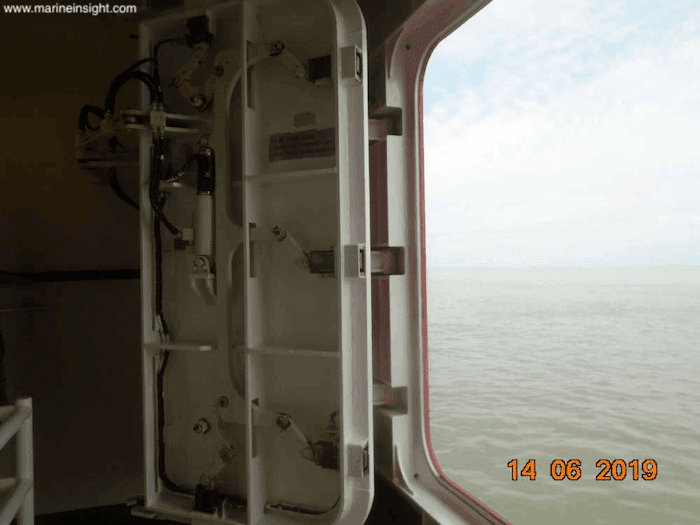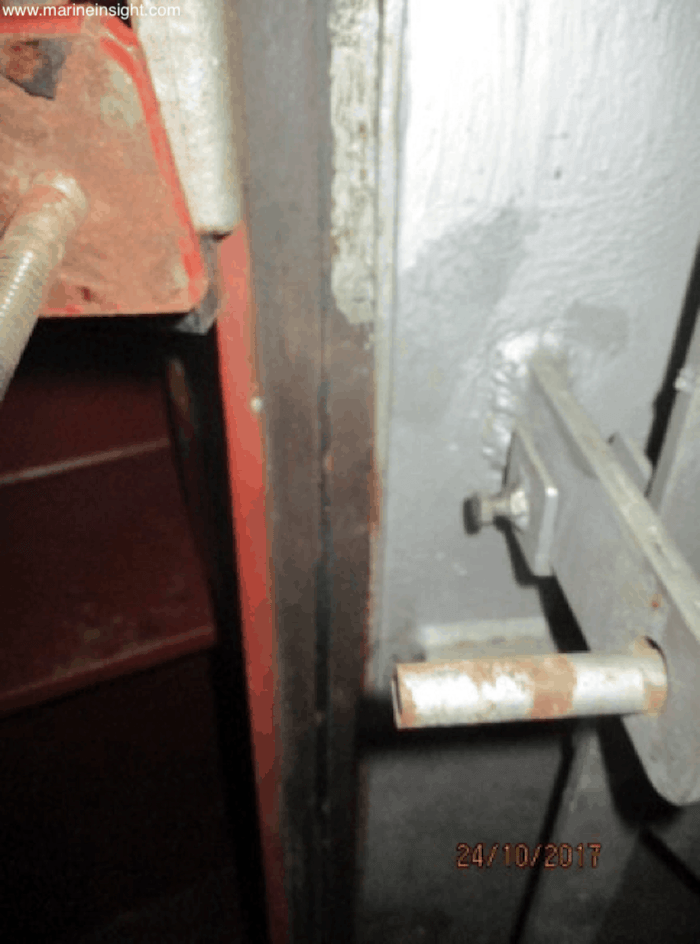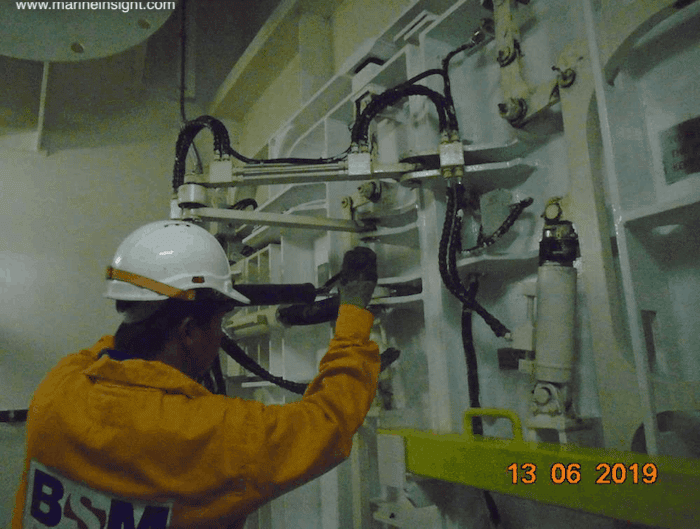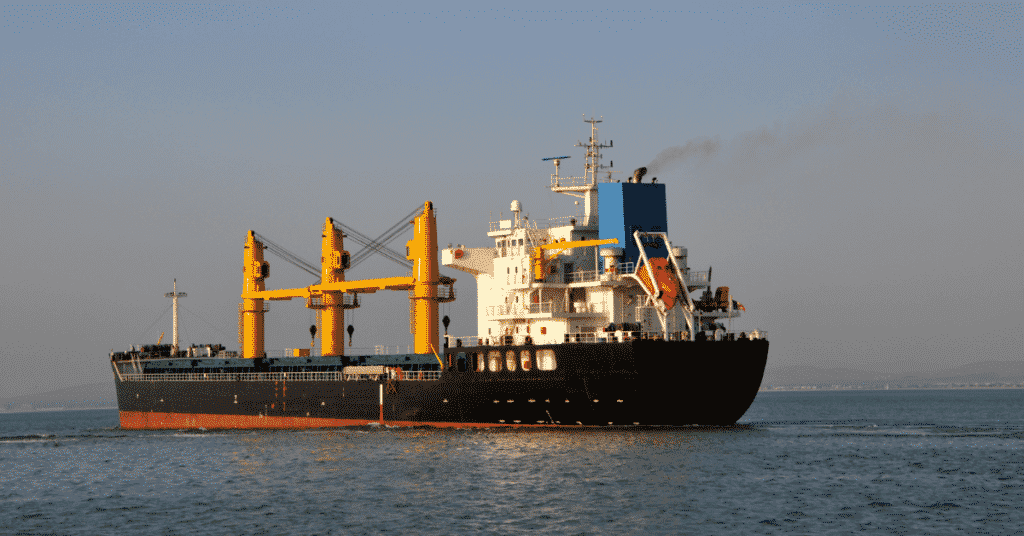Watertight Doors on Ships: Types, Drills, Maintenance & SOLAS Regulations
Watertight doors are special types of doors found on ships that prevent the ingress of water from one compartment to another during flooding or accidents and therefore act as a safety barrier.
It limits the spread of water inside the vessel. These doors are used onboard in many ships such as in the fore and aft passageways underdeck and in engine room bulkheads leading to shaft tunnels in container vessels, large passenger ships, offshore vessels, oil exploration vessels.
They are used in areas where chances of flooding are high. Areas such as engine room compartments and shaft tunnels and some of such places.
Therefore it is important that crew members are familiar with the system as well as the location of different powered watertight doors aboard ship.
Let us first understand the meaning of watertight and weathertight.
Watertight as defined in SOLAS is: capable of preventing the passage of water in any direction under the head of water likely to occur in intact and damaged conditions.
Weathertight is defined as that in any sea conditions water will not penetrate the ship.
To make it simpler, a watertight door can prevent the passage of water in both directions when subjected to a head of water i.e it can withstand water pressure from both sides. They are designed to withstand continuous submersion and are therefore located below waterline like shaft tunnels, ballast tanks, bow thruster compartments etc. all openings below the waterline has to be watertight.
Weathertight doors, on the other hand, is designed to withstand brief submersion. They are located above the waterline and can withstand the weather condition as found offshore which means from the outside.
In this article, we will briefly explain the function and operational requirements of watertight doors.

Watertight doors are categorized into three types, which govern the operation of the watertight doors.
Different Types of Watertight Doors on Ships
TYPE A:
This type of doors may be left open and are to be closed only during an emergency.
TYPE B:
This type of watertight doors should be closed and are made to remain open only when personnel are working in the adjacent compartment.
TYPE C:
This type of watertight doors is to be kept closed all the time. It may be opened only for sufficient time when personnel are passing through the door compartment.
TYPE D:
This type of watertight doors is not SOLAS compliant. These doors shall be closed before the voyage commences and shall be kept closed during navigation. These doors cannot be upgraded to another category.
Hazardous Condition for the Ship When the Doors Need to be Closed
a) When there is restricted visibility.
b) In ports where the port limits off compulsory pilotage limits.
c) Required to be closed when the depth of water is less than 3 times the draught.
d) High traffic density.
e) Other factors when the master feels that the condition is dangerous.
Watertight doors can be further classified into the following types:
Hinged type: A door having a pivoting motion about one vertical or horizontal edge.

Sliding type: A door having a horizontal or vertical motion generally parallel to the plane of the door powered by hydraulic cylinders or electric motors.
Powered watertight doors are extremely heavy and powerful. If used incorrectly, they can maim or kill. Everyone onboard the ship must clearly understand the associated risks and how to operate them safely.
What can be some of the risks associated with power operated sliding door?
- Loss of vessel stability and buoyancy in case of watertight doors left open or leaking during water ingress or internal flooding. Therefore keeping watertight doors closed at all times is vital
- The possibility that smoke and fire might spread through the vessel and cause human injury or damage to the vessel if left open
- Lack of situational awareness or proper understanding of the operation of watertight doors can cause crew member being trapped in the door.
- Human injury – there have been many reports in the shipping industry where seafarers have suffered injury, loss of finger due to poor handling of watertight doors and lack of understanding. It is therefore important that all crew are trained on the correct operating and maintenance procedure. It is always better to have one hand free to operate controls. The crew should be vigilant and aware when the “Door Close” mode has been enabled on the bridge. The crew should also avoid passing through a moving door. Note that the watertight door closes with high force. Any object in the passway of the door will be crushed. The crew should pass through only when the door is completely open.
- Loose or unsecured items if left in the vicinity of the door can cause the operational failure of the doors.
Almost all accidents are avoidable. They are nearly always the result of not following the correct procedures. This is because the door is used so frequently by the crew that they start to oversee the risks or because of poor supervision.
Watertight Doors Drill on Ships
1. Drills for the operation of watertight doors shall take place every week. Also, the doors should be checked before leaving the port.
2. All watertight doors, both hinged and power operated should be operated daily during the rounds.
3. The door should be able to operate from both local and remote places. i.e. bridge and ship control centre.
4. If the door is operated from a remote location, there should be an audio and visual alarm during the closing,
5. There should be an indication of both open and close on the remote place of operation.

Solas Regulations Regarding Closure of Watertight Doors
(As per Solas regulation, SOLAS chapter II-1, watertight doors from regulation 14 to regulation 25)
Powered watertight doors can be operated either locally or remotely from the bridge. LOCAL CONTROL is when the doors are both opened or closed using the door’s own controls. It should be noted that when doors are operated using the BRIDGE CONTROL mode, doors can also be opened using the local controls, however, the door will close immediately once the local control lever is released.

1. All the power operated doors must be capable of closing simultaneously from bridge and Ship Control Center (SCC) is not more than 60 seconds when the ship is in an upright condition.
2. The door shall have an approximate uniform rate of closure under power. The closure time, from the time the door begins to close to the time it closes completely, shall be in no case less than 20 seconds or more than 40 seconds with the ship in an upright condition.
3. In case of hand operation of the door, during a power failure, the door must be closed within 90 seconds.
4. Power-operated sliding doors shall be capable of closing with the ship listed to 15 degrees either side.
5. Power-operated sliding doors should be provided with a local audible alarm distinct from any other alarm in that area which shall sound for at least 5 seconds whenever the door is closed remotely but not more than 10 seconds before the door begins to move. The sound should be audible until the door is completely closed.

6. Controls for opening and closing the door should be provided on either side of the door as well as on the central operating console at the bridge. The control handles are located at least 1.6m above the floor on passenger ships.
7. Remote operating positions at the navigation bridge shall have means of visually indicating whether the doors are open or closed. A red light indicates a door is fully open and a green light indicates that the door is fully closed.
8. The direction of movement should be clearly indicated and displayed at all operating positions.
9. There is also a secondary control station, located above the bulkhead deck so that the powered watertight doors can be closed in the event that a fire or flooding prevents someone reaching them to operate the local controls.
Maintenance of Watertight Doors:
The ship’s planned maintenance system must be followed for carrying out routine inspection and maintenance on watertight doors which should include the correct functioning of the whole system and specifically:
- Warning devices and alarms
- The electric/hydraulic mechanism
- Valves
- Fluid level indicators
- Seals
- lights

It is also important to stick to the manufacturer’s maintenance guide. Before any maintenance work is carried out, warning notices should be posted.
- The door should be free from dirt and loose particles. Door frame and gasket should be cleaned routinely and as and when required. Gaskets can be lubricated with silicone oil.
- Wheels and bearings must be checked for excessive wear and damage. The rails should be cleaned and checked for any damages.


- The hydraulic system should be periodically checked for any leakages. Special attention to be paid to the condition of pumps, hydraulic cylinders, hydraulic hand pump, pipe connections. The oil level must be checked and refilled if necessary. The hydraulic oil and filter must be replaced as per the ship’s PMS.
- Great care should be taken when the doors or areas near the doors are painted. Avoid painting the rubber gaskets and the piston rods on the cylinders.
- Lubrication of the mechanical parts including the cleat bolts, the locking device, wheels, lifting cam and arm of the door should be carried out
- Structural damage in the frame or steel structure should be inspected for during routine inspections – watch out for any cracks, indentations or corrosion.
- All doors shall have the clear operating instructions posted on either side of the door. The assigned category whether A, B, C or D as well as their meaning should be marked on both sides of the door. The instructions should be in the ship’s working language and in a legible condition.
Failure in the proper maintenance and operation of watertight doors can draw the attention of Port State Control inspectors and can be a cause of vessel detention.
Missing portions of gaskets, leakage of hydraulic oil, faulty alarms, lack of door closed indication in remote operating positions are some deficiencies that have been observed during the inspection.
After all, they are designed to keep the vessel safe and therefore watertight doors should never be neglected. Powered watertight doors under no circumstances should be modified, for example, to disable the alarm or to adjust the speed of operation.
They should be identified as safety critical equipment. Neglecting the importance of watertight doors can have a great impact on the watertight integrity of the ship and have disastrous consequences.
All crew members should, therefore, be made familiar with the operation of the watertight doors onboard and the safety precautions to be adopted. Operation of the watertight doors should be a part of onboard training and drill regime.
Doors should not be left open unless has been advised to do so. Keeping watertight doors closed should always be promoted. The safety rounds must ensure the integrity of the accommodation and watertight areas/ weather tight areas around and in accommodation.
When at sea, it is imperative to check all watertight doors are closed. We must understand and acknowledge that it is for our own good and safety of the ship. Nothing should be done which can jeopardise safety onboard ships.
Disclaimer: The authors’ views expressed in this article do not necessarily reflect the views of Marine Insight. Data and charts, if used, in the article have been sourced from available information and have not been authenticated by any statutory authority. The author and Marine Insight do not claim it to be accurate nor accept any responsibility for the same. The views constitute only the opinions and do not constitute any guidelines or recommendation on any course of action to be followed by the reader.
The article or images cannot be reproduced, copied, shared or used in any form without the permission of the author and Marine Insight.
Latest Ship Safety Articles You Would Like:
Do you have info to share with us ? Suggest a correction
Subscribe To Our Newsletters
By subscribing, you agree to our Privacy Policy and may receive occasional deal communications; you can unsubscribe anytime.
Web Stories





























There is no class A B C for W/T doors
It states in SOLAS:
All watertight doors shall be kept closed during navigation except that they may be opened during navigation as specified in paragraphs 3 and 4.
2 Watertight doors located below the bulkhead deck [outside machinery spaces] having a maximum clear opening width of more than 1.2 m shall be kept closed when the ship is at sea, except for limited periods when absolutely necessary as determined by the Administration.
3 A watertight door may be opened during navigation to permit the passage of passengers or crew, or when work in the immediate vicinity of the door necessitates it being opened. The door must be immediately closed when transit through the door is complete or when the task which necessitated it being open is finished.
4 Certain watertight doors may be permitted to remain open during navigation only if considered absolutely necessary; that is, being open is determined essential to the safe and effective operation of the ship’s machinery or to permit passengers normally unrestricted access throughout the passenger area. Such determination shall be made by the Administration only after careful consideration of the impact on ship operations and survivability. A watertight door permitted to remain thus open shall be clearly indicated in the ship’s stability information and shall always be ready to be immediately closed.
Of course there is Types of watertight doors. I work on ship since a couple of years now, and on the one I’m right now, we have category A to D doors (D is splashtight doors..). The article is accurate.
is there any pressure requirements that the door should withstand?
Dear Kaja,
Their are no stated pressure requirement as the it mainly depends on the size of the room the watertight door is protecting. While installation, they are pressure tested for leak (leak test) to ensure there will be no water ingress.
what is the five types of doors on the ship?
I am struggling to find what is the minimum door height (clear opening) I find lots of rules and regulations about door with but nothing on requirements for door height in SOLAS, ABS, and IMO but nothing on how high it should be. Anyone know some rule describing what minimum door height should be?
DEAR FRIENDS,
if some one having Water tight doors standard drawings please forward to my mail id khajadme@gmail.com
what are the closing and openings in a ship and how they are tested and measured?
Hello,
We know it’s important for you to get a quick response for your question.
Thus, we created Marine Insight Forums >> https://forums.marineinsight.com
Kindly re-post your question at the forums, after a quick free sign-up and one our experts will reply to you at the earliest.
Register here now >> https://forums.marineinsight.com
Thanks a lot in advance.
I didn’t know that ships have different types of watertight doors. I’m sure they are all a very important part of keeping the ship safe in the water. It makes sense that they should all remain closes whenever there is restricted visibility or high traffic density. It must be important to have reliable doors. https://products.mcsllcusa.com/cen-tex.html
Dear all,
all your comments are very interesting. However, pls reinforce them with a regulation/ Rule reference. We’ll all learn a bit of it.
Thank you very much.
Have a safe trip.
Classes of doors do exist, but under classification.
There is pressures for the doors, search on google for DNV water tight doors and there is very in depth information, but it is for ship design and construction, not for day to day testing.
Thank You for your input Matt
Are there standards of minimum distance from the deck for the bottom of a watertight door opening and minimum off the deck for the top of a watertight door opening?
Can sb mention points regarding maintenance of Watertight doors?
With what probability of failure per demand can such normally open doors be closed?